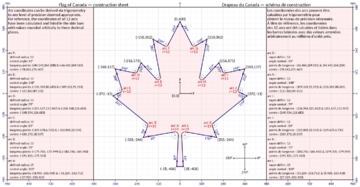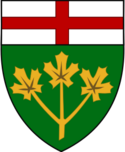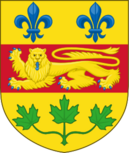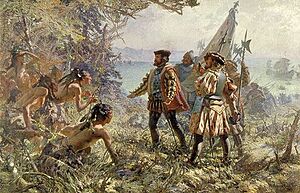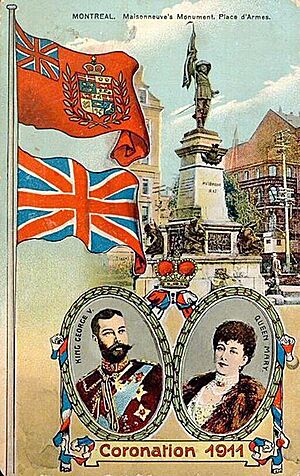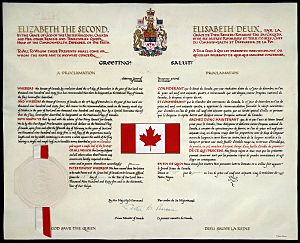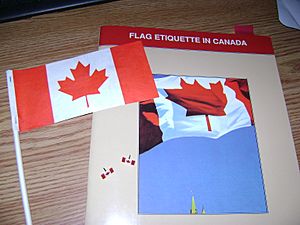Flag of Canada facts for kids
 |
|
| Name | The Canadian Flag
|
|---|---|
| Use | National flag, civil and state ensign |
| Proportion | 1∶2 |
| Adopted | February 15, 1965 |
| Design | A vertical triband of red (hoist-side and fly-side) and white (double width) with one red maple leaf centred on the white band. |
| Designed by | George F. G. Stanley |
The National Flag of Canada, often called the Maple Leaf Flag, is a red flag with a white square in the middle. This white square is twice as wide as the red sections on either side. In the very center of the white square is a red maple leaf with 11 points. This flag was the first to be chosen by both parts of Canada's Parliament and officially announced by the Canadian monarch as the country's national flag. Today, it is Canada's most famous and recognized national symbol.
In 1964, Prime Minister Lester B. Pearson wanted Canada to have its own official flag. This started a big discussion about changing the old flag, which was the Union Flag. A committee was formed to find a new design. They chose a maple leaf design created by historian George Stanley from Mount Allison University. His idea was inspired by the flag of the Royal Military College of Canada. The new flag officially appeared on February 15, 1965. This date is now celebrated every year as National Flag of Canada Day.
Before 1965, Canada often used a flag called the Canadian Red Ensign. It had been used unofficially since the 1860s and became officially approved in 1945 for times when Canada wanted to show its own flag. The Union Jack (also known as the Royal Union Flag) is still an official flag in Canada. It shows Canada's connection to the King or Queen and to the Commonwealth of Nations group of countries. There aren't strict laws about how to use the Canadian flag. But there are polite rules and customs that explain how to display it. These rules say the Canadian flag should always be shown first, before most other flags.
Many flags used by Canadian officials, government groups, and military forces include the maple leaf. Sometimes the Canadian flag is placed in a corner of another flag. Other times, maple leaves are part of the design. The Canadian flag also appears on government logos.
Contents
Understanding the Flag's Design
The Canadian flag looks the same on both sides because it is perfectly balanced. The flag's width is twice its height. The white section in the middle is a special stripe called a "Canadian pale." This stripe is wider than usual, taking up half the flag's width. The red sections on either side are each half the size of the white stripe. A red maple leaf sits in the center of the white stripe. In flag language, the official description says "red on a white Canadian pale, a red maple leaf."
The maple leaf has been a symbol for Canada since the 1800s. It first appeared as a national symbol in 1868 on the coat of arms for both Ontario and Quebec. In 1867, Alexander Muir wrote a patriotic song called "The Maple Leaf Forever." It became a popular song in English-speaking Canada. The maple leaf was later added to the Canadian coat of arms in 1921. From 1876 to 1901, the leaf was on all Canadian coins, and it stayed on the penny after 1901. Canadian soldiers also used the maple leaf as a symbol as far back as 1860. During the First World War and Second World War, Canadian military badges often featured a maple leaf. The maple leaf also appears on the tombstones of Canadian soldiers.
In 1921, King George V officially declared red and white as Canada's national colours. Red came from England's Saint George's Cross, and white came from an old French royal symbol. These colours became Canada's official colours when the Queen's personal Canadian flag was announced in 1962. The Department of Canadian Heritage has specific colour codes to make sure the flag always looks the same when printed.
The number of points on the maple leaf doesn't have a special meaning. Designers chose 11 points because tests showed this design looked best and clearest, even in strong winds.
Jacques Saint-Cyr designed the maple leaf image used on the flag. Some say it was inspired by a design from an Ottawa craft shop. For printing the flag, specific colour codes like PMS 032 (flag red) or PMS 485 (for screens) are used. The red colour also has a specific digital code (#FF0000). In 1984, a law was passed to make sure all Canadian flags are made to the same standards.
Lua error: expandTemplate: template "Pantone" does not exist.
| Scheme | ||
|---|---|---|
| Pantone (Paper) | 032 C | White |
| Web colours |
Lua error: expandTemplate: template "Pantone" does not exist. |
|
| RGB |
Lua error: expandTemplate: template "Pantone" does not exist. |
|
| CMYK |
Lua error: expandTemplate: template "Pantone" does not exist. |
The Canadian flag can also be seen as a digital symbol (emoji) on computers and phones.
A Look at the Flag's History
Early Canadian Flags
When John Cabot arrived in Newfoundland in 1497, he carried the Saint George's Cross. In 1534, Jacques Cartier placed a cross in Gaspé with the French royal symbol, the fleur-de-lis. The Royal Banner of France was important in New France. Different French military flags were used over the years.
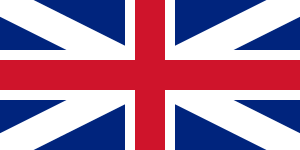
The Union Flag (also called the "Union Jack") was the unofficial British national flag. It was used in Canada from when the British first settled in Nova Scotia after 1621. Its use continued even after Canada became more independent from the United Kingdom in 1931. It was used until the current flag was adopted in 1965. The United Empire Loyalist flag, which looks a lot like the Union Jack, was used by people who stayed loyal to the British King during the American Revolutionary War. Today, this flag is still used in some Canadian communities to show their heritage.
After Canada became a country in 1867, people started to want unique Canadian flags. The first Canadian flag was for the Governor General of Canada. It was a Union Flag with a shield in the middle showing symbols of Ontario, Quebec, Nova Scotia, and New Brunswick, surrounded by maple leaves. In 1870, the Red Ensign flag started to be used unofficially on land and at sea. It had a Canadian shield added to its right side. As new provinces joined Canada, their symbols were added to the shield. In 1892, the British navy approved the use of the Red Ensign for Canadian ships.
The shield on the Red Ensign was changed to the official Canadian coat of arms in 1921. In 1924, the government allowed this flag to be used at Canadian buildings in other countries. In 1925, Prime Minister William Lyon Mackenzie King tried to create a new flag for Canada, but the committee he formed didn't finish its work. Despite this, many Canadians wanted a new flag in the 1920s. New designs were suggested in 1927, 1931, and 1939.
By the Second World War, the Red Ensign was seen as Canada's unofficial national flag. In 1945, a special group from Parliament was asked to suggest an official national flag. They received over 2,400 designs from the public. Archer Fortescue Duguid, a historian, reminded them that red and white were Canada's colours. He also noted that three maple leaves were already on Canada's coat of arms. In 1946, the committee suggested a Canadian Red Ensign with a golden maple leaf on a white background. However, Quebec's government asked the committee not to include symbols like the Union Flag, which they saw as "foreign." Prime Minister Mackenzie King worried that changing the flag might cause problems, so he didn't act on the report. As a result, the Union Flag remained a national flag, and the Red Ensign continued to be flown at government buildings.
The Great Flag Debate
By the 1960s, the discussion about an official Canadian flag became very strong and sometimes heated. This led to the Great Flag Debate in 1964. In 1963, Lester B. Pearson's Liberal government came to power. They decided it was time to choose an official Canadian flag through discussions in Parliament. Pearson was a strong supporter of this change. He had helped solve a big international problem called the Suez Crisis in 1956, and for that, he won the Nobel Peace Prize. During that crisis, Pearson was concerned because Egypt didn't want Canadian peacekeepers. This was because Canada's flag at the time (the Red Ensign) looked too much like the United Kingdom's flag, and the UK was involved in the conflict. Pearson wanted a Canadian flag that was unique and clearly Canadian. The main person against changing the flag was John Diefenbaker, a former prime minister. He strongly believed the old flag should stay.
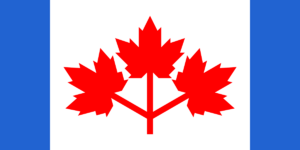
In 1961, Pearson, who was then the Leader of the Opposition, asked John Ross Matheson to research ideas for a new Canadian flag. By April 1963, Pearson was Prime Minister. In May 1964, his government suggested his favourite design: a flag with blue edges and three red maple leaves joined together on a white background. This design was created by artist Alan Beddoe. This led to many weeks of heated discussions in Parliament. People called this design the "Pearson Pennant," and some news outlets made fun of it. Some also saw it as giving too much to Quebec.
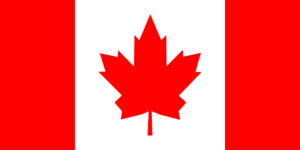
A new committee was formed in September 1964, made up of members from different political parties. Herman Maxwell Batten was the chairman, and John Matheson helped Pearson. Many people shared their ideas with the group. Duguid again suggested a design with three maple leaves. Arthur R. M. Lower stressed the need for a clearly Canadian symbol. Marcel Trudel argued for symbols of Canada's founding nations, which did not include the maple leaf. The committee also looked at about 2,000 suggestions from the public. After six weeks of study and political discussions, the committee voted on two final designs: the Pearson Pennant and the current design. The Conservatives thought the Liberals would vote for Pearson's design, so they voted for the single maple leaf flag. But surprisingly, all the Liberals and members from other parties also voted for the single maple leaf design. This made the vote 15 to 0 for the option created by George Stanley. It was inspired by the flag of the Royal Military College of Canada (RMC) in Kingston, Ontario.
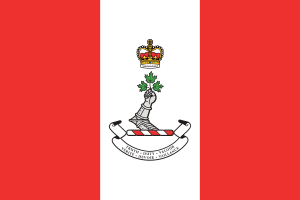
In March 1964, George Stanley, who was the Dean of Arts at RMC, suggested to Matheson that the RMC flag could be the basis for the national flag. Stanley then wrote a memo saying that a new flag should avoid symbols that might divide people, like the Union Flag or the fleur-de-lis. According to Matheson, Pearson's main goal for a new flag was to help keep Quebec as part of Canada. Stanley's idea was for the new flag to be red and white with a single maple leaf. His memo included the first sketch of what would become the flag of Canada. Stanley and Matheson worked together on the design. After six months of debate and many speeches, the House of Commons approved the design on December 15, 1964. Matheson immediately wrote to Stanley, congratulating him. The Senate of Canada also approved it two days later.
The Official Proclamation
After Parliament approved the new flag, an official document, called a proclamation, was prepared for the Queen of Canada to sign. This was a beautiful, decorated document on special paper, with fancy writing by Yvonne Diceman and colourful drawings of symbols. The words were written in black ink with a feather pen. The symbols were painted with special colours and gold accents. The Great Seal of Canada was pressed onto it and held with a silk ribbon.
Queen Elizabeth II signed the document on January 28, 1965. Prime Minister Lester Pearson and Attorney General Guy Favreau also signed it to make it official. The document had to travel to the United Kingdom for the Queen's signature and to the Caribbean for Favreau's signature (he was on vacation). Because it traveled to different places and was stored and repaired with things like tape, the document started to get damaged. The paint flaked off, and the tape left stains. To display it for the flag's 25th anniversary in 1989, the document was carefully repaired. Today, the proclamation is stored in a special case that controls temperature and humidity to protect the paper.
Adopting the New Flag
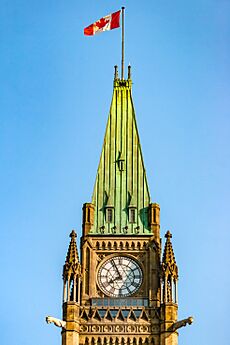
The new national flag was officially raised on February 15, 1965, at a ceremony on Parliament Hill in Ottawa. Governor General Georges Vanier, the Prime Minister, and other government members were there. At noon, the old Red Ensign flag was lowered, and the new maple leaf flag was raised. The crowd sang "O Canada" followed by "God Save the Queen". Governor General Vanier said the new flag would show everyone Canada's unity and strong spirit. Maurice Bourget, who led the Senate, said the flag represents all Canadians, no matter their background or beliefs. Some people were very upset about the change, and Stanley even received threats. Despite this, Stanley attended the flag-raising ceremony.
For the flag's 50th anniversary in 2015, some people criticized the government for not holding a big official ceremony. The Minister of Canadian Heritage, Shelly Glover, said this wasn't true, and others pointed out that many community events were happening across the country. However, Governor General David Johnston did lead an official ceremony in Ottawa. He said the flag is a huge part of Canada's life and identity. Queen Elizabeth II also shared her happiness for the flag's 50th anniversary, calling it a "unique and cherished symbol" of Canada. Canada Post and the Royal Canadian Mint released a special stamp and coin to mark the occasion.
In February 2025, leading up to the flag's 60th anniversary, former prime ministers Kim Campbell, Jean Chrétien, Joe Clark, Stephen Harper, and Paul Martin encouraged Canadians to show their national pride. They asked people to fly the flag "like never before" because of some challenges to Canada's independence from the United States.
Other Canadian Flags
The Royal Union Flag is another official Canadian flag, flown on special days. It shows Canada's membership in the Commonwealth of Nations and its connection to the King or Queen. Government buildings are asked to fly the Royal Union Flag next to the Canadian flag on certain days. These include Commonwealth Day (the second Monday in March), Victoria Day (the King's official birthday), and December 11 (the anniversary of the Statute of Westminster 1931, a law about Canada's independence). It can also be flown at the National War Memorial or other places during ceremonies that remember Canada's role with other Commonwealth countries in wars. The Canadian flag always gets the most important spot.
The Royal Union Flag is also part of the flags of Ontario and Manitoba. A special version of it is used on the flag of British Columbia and the flag of Newfoundland and Labrador. Many provincial lieutenant governors used to have flags that included a modified Union Flag. The lieutenant governor of Nova Scotia was the last to stop using this design in 2024.
The sovereign's flag for Canada is an official flag that was introduced on May 6, 2023. It was first flown at Government House in Halifax on that day.
The Red Ensign is sometimes still used, especially at some ceremonies. For example, it was flown at the events remembering the Battle of Vimy Ridge in 2007. Some people criticized this, saying it shouldn't be treated the same as the Canadian flag. Others praised it, believing it was important to remember Canada's past connections. The Royal Union Flag and Red Ensign are still flown in Canada by groups of veterans and others who want to highlight Canada's British heritage and its link to the Commonwealth.
In Quebec, the provincial flag (a white cross on a blue background with four fleurs-de-lis) can be seen as a national flag alongside the Maple Leaf flag. The Acadian flag is also important in the Acadian areas of the Maritime provinces. It is not common to see Canadian flags displayed in Quebec. Most Quebecers prefer to fly the flag of Quebec instead. The display of flags can be a sensitive topic there. The Quebec government has ordered that the Quebec flag should be given priority over the Canadian one in the province. Many Quebec government buildings, like the Quebec City Hall, do not fly the Canadian flag at all.
Flag Rules and Etiquette

There is no law that tells people exactly how to use the Canadian flag. However, Canadian Heritage has published guidelines for flying the National Flag of Canada, both alone and with other flags. These guidelines cover things like the order in which flags should be placed, where the flag can be used, and how people should show respect for the flag. These suggestions, called National Flag of Canada Etiquette, are available online and were last updated on February 24, 2022. The Canadian Forces also have a special way of folding the Canadian flag for ceremonies, like funerals. They don't suggest this method for everyday use.
The flag can be displayed every day at government buildings, airports, military bases, diplomatic offices, and by citizens at any time. When flying the flag, it should be on its own pole and should not be lower than other flags. The only flags that can be higher are, in order from highest to lowest: the sovereign's flag for Canada, the governor general's flag, any personal flags of members of the Canadian Royal Family, or flags of the lieutenant governors. The Canadian flag is flown at half-mast (halfway up the pole) to show a period of mourning.
Sharing the Flag with Canadians
Since the Canadian flag was adopted in 1965, the Canadian government has created programs to help people learn about and use the flag. Examples include the Canadian Parliamentary Flag Program and a flag program run by the Department of Public Works. These programs helped more people see the flag and understand that it is a part of Canada's identity. To spread awareness of the new flag, the Parliamentary Flag Program started in 1972. From 1973, members of Parliament could give out flags and flag pins to people in their areas. Full-size flags that have flown on the Peace Tower and four other places on Parliament Hill are given to the public for free. As of March 2019, there was a waiting list of over 100 years for these flags.
Since 1996, February 15 has been celebrated as National Flag of Canada Day. In 1996, Minister of Canadian Heritage Sheila Copps started the One in a Million National Flag Challenge. This program cost about $15.5 million, with some of the cost covered by donations.
Images for kids
-
Sovereign's flag for Canada (used by Charles III, King of Canada)
See also
 In Spanish: Bandera de Canadá para niños
In Spanish: Bandera de Canadá para niños


